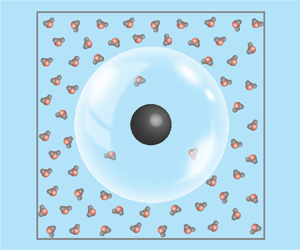Article contents
The effects of nanoscale nuclei on cavitation
Published online by Cambridge University Press: 25 January 2021
Abstract

Under certain conditions, experimental values of the tensile strength of water are found to be much lower than theoretical values, even when the water is purified and degassed as much as possible. The discrepancy could be ascribed to stabilized nanobubbles or nanoparticles suspended in the liquid, as such contaminants cannot be eliminated completely from a substantial liquid volume. Thus, the present study aims at elucidating the effects of such nanoscale nuclei on cavitation. A parameter-free mathematical model is derived to predict the cavitation arising from nanoscale nuclei, based on classical nucleation theory. To verify the model, molecular dynamics is used to simulate cavitation at nuclei of different sizes, embedded either in water or in liquid copper at different temperatures. The cavitation pressures calculated from the molecular dynamics results are compared with the predictions of the present mathematical model, with a good agreement between them. The results show that nanoscale nuclei significantly promote cavitation, i.e. the tensile strength is reduced notably by the presence of nanoscale nuclei. The tensile strength decreases when the size of nuclei increases, and the change rule of cavitation pressure is also affected by the liquid properties, such as liquid temperature. The present study may provide an acceptable explanation of the discrepancy between theory and experiment on the cavitation pressure in liquids purified and degassed as much as possible.
JFM classification
- Type
- JFM Papers
- Information
- Copyright
- © The Author(s), 2021. Published by Cambridge University Press
References
REFERENCES
- 15
- Cited by



